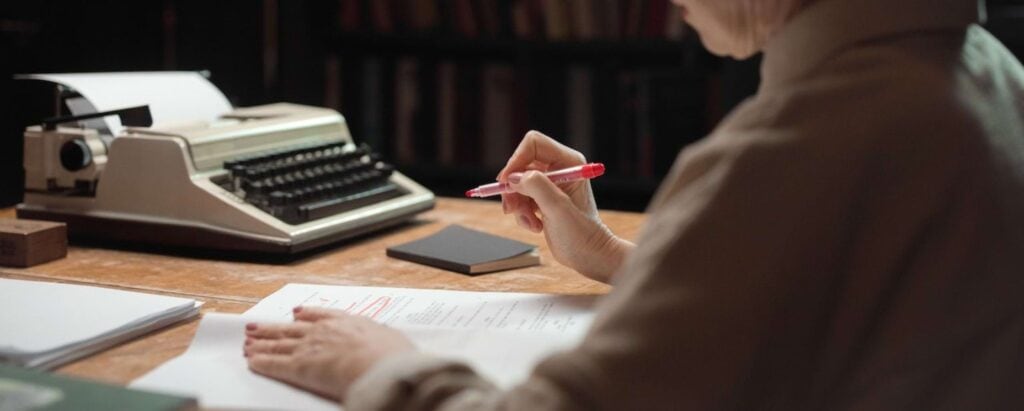Disclosure: This post may contain affiliate links. If you click on a link I may make a small commission at no extra cost to you. You can read the full disclosure here.
Last Updated on October 22, 2022 by Chris Panteli
What to Look for When Proofreading
Whether you have some writing you’re trying to proofread or you’re thinking about becoming a professional proofreader, you might have thought about what you should be looking for.
You need a keen eye and attention to detail to proofread any type of content, and the technique will change depending on the type of content.
This post will show you what to look for when proofreading and how a professional proofreader works.
Want to know how you can make extra money every month by proofreading? Head to our next guide on starting a proofreading business.
Learn How To Start Your Own Proofreading Business
Alicia made $1,100 the first month after she graduated from one of Caitlin’s proofreading courses – even while she was still working full-time at her retail banking job!

Types of Proofreading

If you’re thinking about becoming a proofreader to earn some extra cash, you’ll need to decide what kind of proofreading you want to do. There are four broad categories of proofreading:
- Print media proofreading – for self-published authors or publishers (e.g., newspapers, books, magazines, etc.)
- Academic proofreading – for researchers, professors, and students (e.g., research papers, articles, theses, etc.)
- Business proofreading – for business owners (e.g., blogs, website content, marketing materials, etc.)
- Translation proofreading – making sure translated materials make sense.
Techniques Used in Proofreading
There is no set technique for proofreading, and most professionals have different approaches. However, there are some common tasks that all proofreaders do:
- Correct errors with punctuation, grammar, capitalization, and spelling.
- Fix improper word choices.
- Look for missing or repeated words
- Ensure the content follows the appropriate style guide (if there is one).
Most proofreaders use either Microsoft Word or Google Docs to proof content. Both programs have tracking features that let you mark any changes you make to the document.
Clients need this feature to see all your changes and ensure they’re happy with them all. Once approved, it’s easy to accept and merge all the changes with the original text.
What Do Proofreaders Look For?

Professional proofreaders have a list of things they look for when reviewing someone’s writing. Here’s a quick breakdown of what proofreaders look for and why it’s essential.
Spelling
It’s easy to make spelling mistakes when writing, and spell check won’t flag them all. So it’s your job to check the spelling is correct and consistent throughout.
For example, if a client uses American English, it’s important to check the spelling doesn’t switch between British and American English.
Punctuation
Punctuation is something that many people struggle with, and it’s easy to get wrong. As a proofreader, it’s your job to know where commas should be, where semi-colons are needed, and where punctuation is misused.
If you are proofreading blogs or online content, this can be a little more tricky. Since sentences are much shorter online and language is more conversational, you’ll need to know how to shorten sentences and simplify the writing, so less punctuation is needed.
Tone
The tone of an academic paper is vastly different from a food blog. But having a consistent tone is important, no matter the writing style.
Proofreaders know how to make subtle changes in writing to keep the tone consistent. This might mean changing certain words or sentence structure so the writer’s voice shines through.
Capitalization
Names and proper nouns are capitalized in sentences, which is something else proofreaders check for. For example, days, months, and holidays are all proper nouns, whereas seasons aren’t.
As a proofreader, it’s your job to know what should be capitalized and to keep it consistent throughout the content.
Placeholders
Many writers use placeholders if there is something they need to come back to later. For example, they might insert [PLACE NAME] if they need to research it but don’t want to lose the flow of writing.
It’s easy to forget placeholders and send the work to a proofreader with them still in the text. Proofreaders will flag any placeholders, so the writer knows they need to review them and make changes.
Syntax
Syntax is how you string a sentence together. It’s easy to get this wrong while writing, which is why proofreaders are so useful. Here’s a great example of poor vs. good syntax:
- I have a bed for a cat shaped like a hotdog.
- I have a hotdog-shaped bed for a cat.
This does fall into the realm of professional editing, but it’s easy to spot sentences that could be better while proofing.
Formatting
Different types of writing will require different formatting, and most clients will give you a style guide with formatting requirements.
For example, a research paper needs to be double-line spaced, with a 12-point font and aligned text.
On the other hand, a blog post will need H1, H2, and H3 headings and short paragraphs.
Accuracy
As part of the proofreading process, you might also offer fact-checking. This checks the accuracy of the content by looking at the accuracy of stats, dates, author names, etc.
If errors are found, proofreaders flag the issue and let the author review their work.
Not all proofreaders offer fact-checking, but you can charge more for your services if you do.
Numbering
This one is nice and simple – you’ll need to make sure lists are numbered correctly and numbered items are correct.
For example, if someone says they will talk about five points and only mention four, you’ll need to flag it or change the numbering.
Links
As a final step, it’s important to check that all links are working and there are no broken links in the content. This is only relevant for online content such as blogs or websites.
Tips for Common Proofreading Errors

After proofreading for a while, you’ll notice that people tend to make the same common errors repeatedly. By being familiar with common errors, they’re much easier to spot:
- Mixing up they’re, their, and there.
- Missing or double words.
- Homophones (which are words that sound the same but have different meanings). For example, bear and bare, hear and here, peace and piece, etc.
- Misplaced apostrophes (e.g., childrens’ vs. children’s)
What to Do After You’re Done Proofreading
After you’ve finished proofing, run your work through a grammar checker such as Grammarly to do a final sweep.
Online software doesn’t always get it right, but it’s great for picking up those final errors you may have missed. Grammarly also gives the text a score so you can see how readable it is.
If you’re proofreading your own writing, it’s always best to get someone else to proof it for you, too.
We naturally read over errors when reading our own work because we know what we’re trying to say. Other people offer a fresh perspective and will pick up on errors you’ve missed.
Conclusion
Proofreading is a crucial step in any writing process. Whether you’re writing a blog for a website or a thesis for a Ph.D., proofreading ensures the writing is error-free and ready to publish.
Since proofreading is so important, there’s also a huge demand for talented proofreaders. If you have a keen eye for detail and a strong grasp of your language, you could make a lucrative side hustle out of proofreading.
Make sure to head to our next guide, where we share the exact process you need to start making money proofreading.







